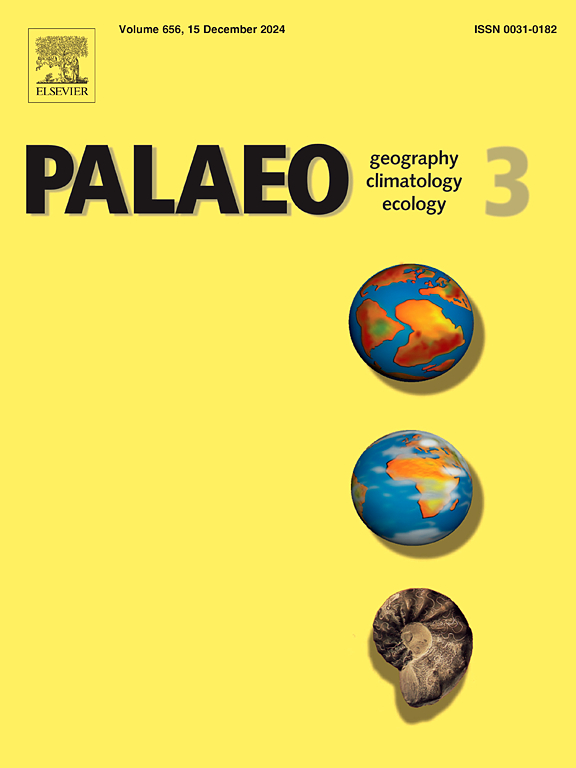Middle to late Miocene cooling and drying in the northern Tibetan Plateau based on evidence from plant-insect interactions
IF 2.6
2区 地球科学
Q2 GEOGRAPHY, PHYSICAL
Palaeogeography, Palaeoclimatology, Palaeoecology
Pub Date : 2024-09-18
DOI:10.1016/j.palaeo.2024.112496
引用次数: 0
Abstract
The Qaidam Basin in the northern Tibetan Plateau is currently arid, but may have had a semi-humid to semi-arid climate in Miocene times, as suggested by pollen and isotopic data; however, the lack of macroscopic fossils hinders more precise paleoclimatic calibration. In this paper, we report fossil leaves with insect damage from a late Miocene layer (HT-5) in the Huaitoutala section dated ∼11.4 Ma, and compare them with records from a middle Miocene layer (HT-1) dated ∼12.7 Ma. Results show that damage diversity dropped from 36 types in HT-1 to 24 types in HT-5, suggesting a fall in mean annual temperature. Damage frequency decreased from 70 % in HT-1 to 32 % in HT-5, pointing to a drop in the coldest month temperature. Moreover, a slight fall in the diversity of mining damage, from 5 types in HT-1 to 4 types in HT-5, suggests a shift towards a slightly more arid climate from the middle to late Miocene. The flora from HT-5 is composed mainly of Betulaceae, Populus, Ulmus, and shrubs. Based on the distribution of these taxa in modern vegetation, the climate was probably semi-humid, not entirely arid during the late Miocene. These results are corroborated by fossil mammal data from the same section. Therefore, despite a cooling and drying trend from the middle to late Miocene, the climate of the Qaidam Basin was not as extremely arid as today.
基于植物-昆虫相互作用证据的青藏高原中新世中期至晚期的冷却和干燥过程
青藏高原北部的柴达木盆地目前气候干旱,但花粉和同位素数据表明,中新世时期可能曾有过半湿润到半干旱气候;然而,宏观化石的缺乏阻碍了更精确的古气候校准。本文报告了Huaitoutala剖面中新世晚期地层(HT-5)中的虫害叶化石,年代为11.4 Ma∼,并将其与中新世中期地层(HT-1)中的虫害叶化石(年代为12.7 Ma∼)进行了比较。结果表明,损害多样性从 HT-1 的 36 种下降到 HT-5 的 24 种,表明年平均温度下降。损害频率从 HT-1 的 70% 降至 HT-5 的 32%,表明最冷月温度下降。此外,采矿损害的多样性也略有下降,从 HT-1 的 5 种降至 HT-5 的 4 种,这表明从中新世中期到晚期,气候变得略为干旱。HT-5 的植物区系主要由桦木科、杨树、榆树和灌木组成。根据这些类群在现代植被中的分布情况,中新世晚期的气候可能是半湿润而非完全干旱的。同一地段的哺乳动物化石数据也证实了这些结果。因此,尽管从中新世中期到晚期出现了冷却和干燥的趋势,但柴达木盆地的气候并不像今天这样极端干旱。
本文章由计算机程序翻译,如有差异,请以英文原文为准。
求助全文
约1分钟内获得全文
求助全文
来源期刊
CiteScore
5.90
自引率
10.00%
发文量
398
审稿时长
3.8 months
期刊介绍:
Palaeogeography, Palaeoclimatology, Palaeoecology is an international medium for the publication of high quality and multidisciplinary, original studies and comprehensive reviews in the field of palaeo-environmental geology. The journal aims at bringing together data with global implications from research in the many different disciplines involved in palaeo-environmental investigations.
By cutting across the boundaries of established sciences, it provides an interdisciplinary forum where issues of general interest can be discussed.

 求助内容:
求助内容: 应助结果提醒方式:
应助结果提醒方式:


